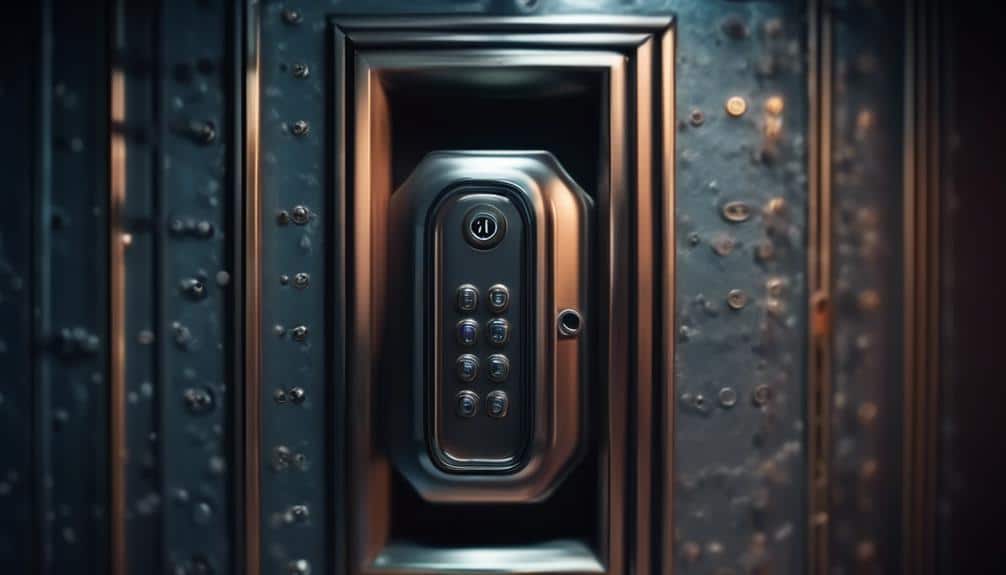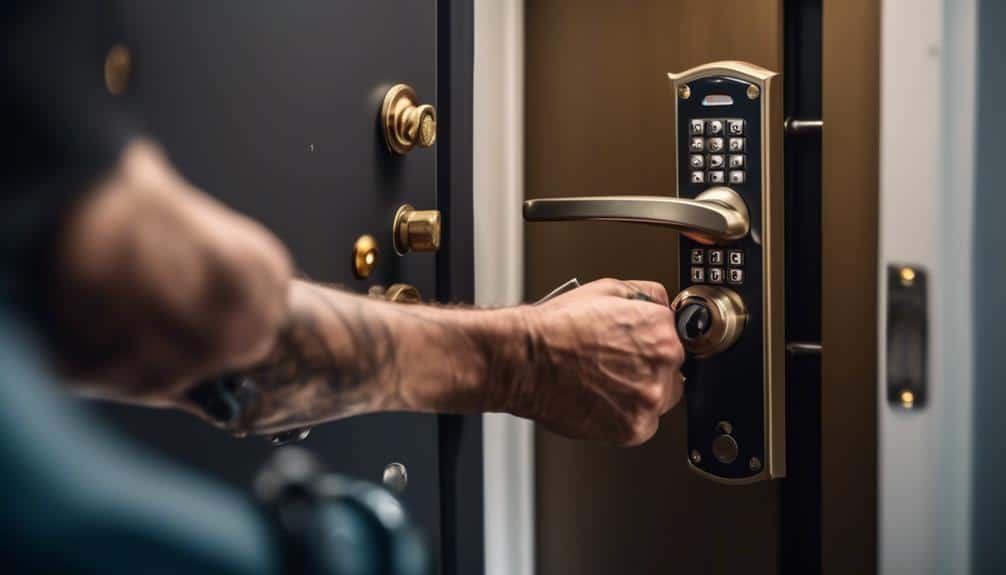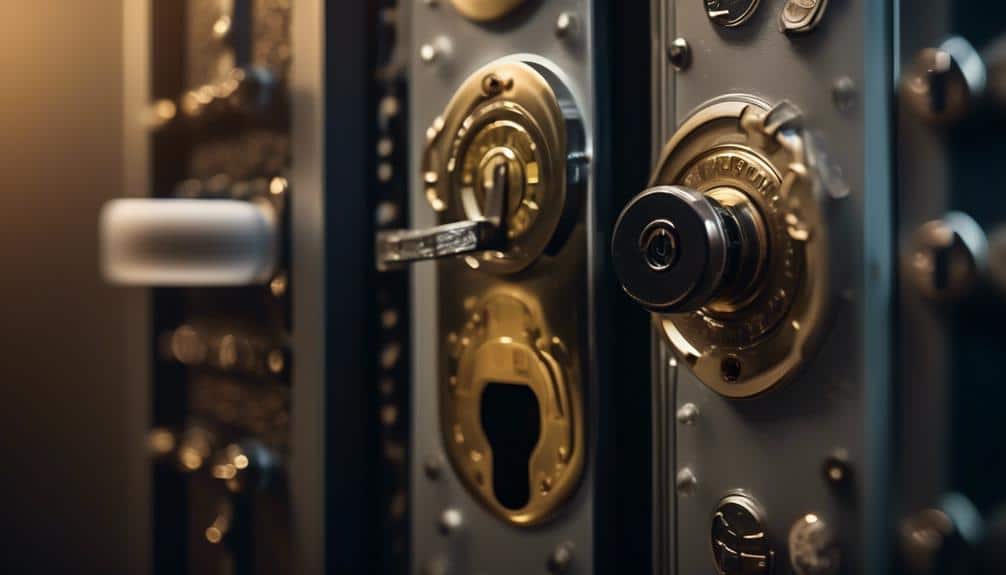They say that 'better safe than sorry,' and when it comes to panic rooms, this age-old adage couldn't be more relevant.
In a world where safety concerns are increasingly prevalent, having a high-security lock for your panic room is not just a luxury, but a necessity.
But why are these locks so vital? Well, in this discussion, we will explore the reasons behind the importance of high-security locks for panic rooms, and how they play a crucial role in ensuring your safety and peace of mind.
So, let's dive into the world of high-security locks and discover why they are an essential component of any panic room setup.
The Importance of High-Security Locks

High-security locks are essential for panic rooms due to their ability to provide maximum protection and prevent unauthorized access. One of the advantages of using keyless entry systems is the convenience they offer. With a keyless entry system, there's no need to carry around keys or worry about losing them. Instead, access to the panic room can be granted through the use of a code or biometric identification, such as a fingerprint or iris scan. This eliminates the risk of keys falling into the wrong hands or being duplicated without authorization.
Furthermore, the impact of technology on high-security locks has revolutionized the level of security they can provide. Advanced technologies, such as encryption algorithms and tamper-resistant sensors, make it extremely difficult for intruders to bypass the lock system. Additionally, high-security locks can be integrated with smart home systems, allowing for remote monitoring and control. This means that homeowners can have peace of mind knowing that they can monitor their panic room's security even when they're away from home.
Types of High-Security Locks

What are the different types of locks that provide high-security for panic rooms?
When it comes to securing a panic room, there are two main types of high-security locks to consider: electronic and mechanical locks. Let's explore the pros and cons of each:
- Electronic Locks: These locks offer keyless entry systems, providing convenience and ease of use. They typically utilize a keypad or biometric technology for access control. The advantages of electronic locks include the ability to change access codes easily, integration with security systems, and the option for remote monitoring. However, they can be vulnerable to power outages or hacking attempts, and their installation and maintenance costs can be higher compared to mechanical locks.
- Mechanical Locks: These locks rely on traditional key mechanisms for access control. They're known for their reliability and durability. Mechanical locks don't require power, making them more resistant to power outages and hacking attempts. They also tend to have lower installation and maintenance costs compared to electronic locks. However, they may lack the convenience of keyless entry systems and the ability to integrate with security systems.
Features to Look for in High-Security Locks

When selecting high-security locks for panic rooms, it's important to consider key features that enhance their effectiveness and reliability. Advanced lock technology plays a crucial role in ensuring the security of the panic room. Look for high-security locks that utilize advanced encryption algorithms and tamper-resistant mechanisms. These features make it extremely difficult for unauthorized individuals to bypass the lock and gain access to the panic room.
In addition to advanced lock technology, it's essential to choose high-security locks from top-rated lock manufacturers. These manufacturers have a proven track record of producing reliable and durable locks that offer superior protection. They invest heavily in research and development to stay ahead of emerging threats and constantly improve their lock designs.
Another important feature to consider is the level of pick resistance offered by the high-security lock. Look for locks that have been independently tested and certified to resist picking attempts. This ensures that even skilled lock pickers would have a hard time gaining access to the panic room.
Lastly, consider the durability and construction of the lock. High-security locks should be made from robust materials such as hardened steel to withstand physical attacks. They should also have reinforced strike plates and anti-drill features to prevent forced entry.
Benefits of High-Security Locks for Panic Rooms

Implementing high-security locks in panic rooms provides a range of benefits, ensuring optimal protection and peace of mind in emergency situations. When considering panic room design, it's crucial to prioritize the selection of high-security locks that offer advanced features.
Here are three key benefits of high-security locks for panic rooms:
- Enhanced Security: High-security locks are designed to withstand forced entry attempts, providing a strong barrier against intruders. These locks are made from durable materials and incorporate innovative mechanisms that make them resistant to picking, drilling, and other common break-in techniques. With high-security locks, homeowners can have confidence in the safety of their panic rooms, knowing that unauthorized access is highly unlikely.
- Quick and Easy Access: In emergency situations, every second counts. High-security locks for panic rooms are designed to provide quick and easy access to authorized individuals. These locks often feature advanced locking mechanisms such as biometric fingerprint scanners or keypad entry systems, allowing occupants to unlock the door swiftly without fumbling for keys. This ensures that individuals can enter the panic room promptly and seek refuge without delay.
- Peace of Mind: Panic rooms serve as a sanctuary during dangerous situations, providing a safe haven for residents. By implementing high-security locks, homeowners can have peace of mind, knowing that their panic room is equipped with the highest level of protection available. This sense of security allows individuals and their families to feel more at ease, knowing they've a reliable and secure space to retreat to in times of crisis.
How High-Security Locks Enhance Safety

To further maximize the security and protection of panic rooms, high-security locks offer a crucial layer of defense against potential intruders or threats. These locks are designed to be highly effective in preventing break-ins and deterring intruders, ensuring the safety of individuals inside the panic room.
High-security locks are specifically engineered to withstand various types of attacks. They're constructed with durable materials and advanced locking mechanisms that make them extremely difficult to pick or manipulate. With features such as anti-drill plates and hardened steel bolts, these locks provide a high level of resistance against forced entry attempts.
The effectiveness of high-security locks lies in their ability to withstand different techniques used by intruders, such as lock picking, bumping, or drilling. These locks are designed with complex keyways and unique key systems, making unauthorized access virtually impossible. Additionally, some high-security locks use electronic or biometric technology, further enhancing their security level.
Beyond their physical strength, high-security locks play a crucial role in deterring intruders. The presence of these locks sends a clear message that breaking into the panic room will be extremely challenging, if not impossible. This acts as a strong deterrent, dissuading potential intruders from attempting to gain access to the room.
Factors to Consider When Choosing High-Security Locks

Consideration of important factors is crucial when selecting high-security locks for panic rooms. These locks play a vital role in ensuring the safety and security of individuals during emergency situations. Here are three key factors to consider when choosing high-security locks:
- Resistance to Forced Entry: One of the primary benefits of high-security locks is their ability to resist forced entry. Look for locks that are designed with strong materials, such as hardened steel, and have additional features like anti-drill plates and reinforced strike plates. These elements make it extremely difficult for intruders to break through the lock, providing an extra layer of protection.
- Key Control and Duplication: Key control is another important factor to consider. High-security locks often come with restricted keyways, which means that only authorized individuals can duplicate keys. This helps prevent unauthorized access to the panic room and enhances overall security.
- Lock Reliability: In emergency situations, reliability is crucial. Look for locks that are tested and certified by reputable organizations to ensure that they meet industry standards for strength and durability. Additionally, consider locks that offer features such as corrosion resistance, as they'll ensure the lock's longevity and functionality over time.
Installation and Maintenance of High-Security Locks

When it comes to the installation and maintenance of high-security locks, there are two key points to consider.
First, understanding the different lock types and features is crucial in choosing the right locks for a panic room. From biometric locks to keyless entry systems, each option has its own advantages and limitations.
Second, regular maintenance is essential to ensure the continued functionality and reliability of these locks. This includes routine inspections, lubrication, and prompt repair of any issues that may arise.
Lock Types and Features
We will now explore the different types of high-security locks and their key features, focusing on the installation and maintenance process.
- Deadbolt Locks: These locks are the most common choice for panic rooms due to their robust construction and resistance to lock picking techniques. Deadbolt locks are installed on the inside of the door and can only be opened with a key or a thumbturn from the inside, providing an additional layer of security.
- Biometric Locks: Leveraging advanced technology, biometric locks use unique physical characteristics, such as fingerprints or retinal scans, to grant access. These locks offer a high level of security as they're virtually impossible to pick or duplicate. Biometric locks require regular maintenance to ensure accurate readings and to update the stored biometric data.
- Electronic Locks: These locks utilize a keypad or a keycard system to control access. They offer the convenience of being programmable, allowing for easy addition or removal of authorized users. Electronic locks are resistant to lock picking techniques and can be integrated with alarm systems for added security.
Importance of Regular Maintenance
Regular maintenance is essential for ensuring the optimal performance and longevity of high-security locks in panic rooms. By conducting regular maintenance, individuals can identify any potential issues or malfunctions before they compromise the security of the panic room. This preventive measure helps to ensure that the locks are in proper working condition and can effectively withstand any attempted breaches.
Regular maintenance includes inspecting the lock components, such as the cylinder, latch, and strike plate, and ensuring that they're clean, lubricated, and free from any damage or wear. Additionally, regular maintenance allows for the adjustment and tightening of any loose or misaligned parts, further enhancing the security measures of the panic room.
Industry Standards for High-Security Locks

To establish uniformity and ensure maximum effectiveness, the high-security lock industry has developed stringent industry standards. These standards are designed to ensure that high-security locks meet specific criteria and are capable of withstanding various threats.
Here are three key elements that are included in the industry standards for high-security locks:
- Industry Certifications: High-security locks undergo rigorous testing and evaluation to obtain industry certifications. These certifications validate the lock's ability to resist forced entry, picking, drilling, and other common attack methods. Examples of industry certifications include UL 437 and ANSI/BHMA Grade 1.
- Testing Protocols: High-security locks are subjected to standardized testing protocols to assess their resistance to different types of attacks. These protocols often involve simulated attacks using specialized tools and techniques. The locks must pass these tests to meet the industry standards.
- Performance Requirements: The industry standards specify certain performance requirements that high-security locks must meet. These requirements include factors like durability, operational reliability, and resistance to environmental conditions. By meeting these requirements, locks can provide the necessary level of security for panic rooms.
Frequently Asked Questions
How Much Does It Cost to Install High-Security Locks in a Panic Room?
When considering the cost of installing high-security locks in a panic room, there are a few factors to keep in mind. These cost considerations include the type of locks chosen, the level of security desired, and the complexity of installation.
However, the benefits of high-security locks can't be overlooked. They provide peace of mind by ensuring that only authorized individuals can access the panic room, offering a reliable barrier against potential threats.
Can High-Security Locks Be Easily Picked or Bypassed?
High-security locks are crucial for panic rooms due to their effectiveness in preventing unauthorized access. They provide a reliable barrier against common methods used to bypass locks, such as lock picking or lock bumping. These high-security locks are engineered with advanced features, including anti-pick pins and reinforced materials, making them extremely difficult to compromise.
Ensuring the safety and security of individuals inside panic rooms, these locks are an essential component that can't be easily picked or bypassed.
Are High-Security Locks Resistant to Drilling and Other Physical Attacks?
High-security locks are designed to provide resistance against lock picking and effectiveness against forced entry. They're specifically engineered to withstand drilling and other physical attacks. With advanced features such as hardened steel construction and anti-drill pins, these locks offer a higher level of security compared to standard locks.
Their robust design ensures that they're highly resistant to tampering, making them vital for protecting valuable assets and ensuring the safety of individuals in panic rooms.
Can High-Security Locks Be Integrated With Other Security Systems in a Panic Room?
Integrating high-security locks with other security systems in a panic room offers numerous benefits. It enhances the overall security of the room, creating a robust defense against intruders.
However, compatibility challenges may arise when trying to integrate different security technologies. These challenges can be overcome by ensuring proper planning, selecting compatible systems, and utilizing professional expertise.
Are High-Security Locks Suitable for Residential Panic Rooms or Just Commercial Applications?
High-security locks are suitable for residential panic room applications, not just commercial settings. These locks provide numerous benefits in residential settings. They offer enhanced protection and peace of mind for homeowners, ensuring that their panic room remains secure during emergencies.
High-security locks have advanced features such as pick-resistant cylinders and reinforced strike plates, making them extremely difficult to bypass. With these locks, homeowners can rest assured that their panic room is equipped with the highest level of security.

